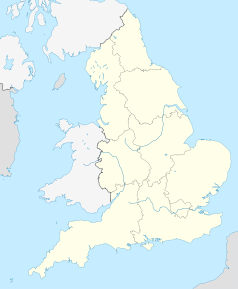Lydd
| ||
(c) Simon Carey, CC BY-SA 2.0 Centrum miasta | ||
| Państwo | ||
| Kraj | ||
| Region | South East England | |
| Hrabstwo | Kent | |
| Dystrykt | Folkestone and Hythe | |
| Populacja (2001) • liczba ludności | 5782 [1] | |
| Nr kierunkowy | 01797 | |
| Kod pocztowy | TN29 | |
Położenie na mapie Kentu Contains Ordnance Survey data © Crown copyright and database right, CC BY-SA 3.0 | ||
Położenie na mapie Wielkiej Brytanii (c) Karte: NordNordWest, Lizenz: Creative Commons by-sa-3.0 de | ||
| Portal | ||
Lydd – miasto w Anglii, w hrabstwie Kent, w dystrykcie Folkestone and Hythe. Leży 45 km na południowy wschód od miasta Maidstone i 95 km na południowy wschód od centrum Londynu[1]. W 2001 miasto liczyło 5782 mieszkańców.
Przypisy
- ↑ Lydd na mapie (ang.). getamap.ordnancesurvey.co.uk. [dostęp 2010-10-06].
Media użyte na tej stronie
(c) Karte: NordNordWest, Lizenz: Creative Commons by-sa-3.0 de
Location map of the United Kingdom
Flag of England. Saint George's cross (a red cross on a white background), used as the Flag of England, the Italian city of Genoa and various other places.
(c) Simon Carey, CC BY-SA 2.0
High Street, Lydd. The first record of a town being her is the 9th century when the Saxons called it Hlydda meaning shore. Built on a shingle bar and often isolated by marshes and water the town has a feel of a frontier town in the American west rather than genteel Kent. Naturally, the smuggling trade found a welcome home here from the 14th century onwards when the Owlers (name derived from their making noises like an owl at night to communicate with each other) smuggled wool to France. During the 18th and 19th century it was often said that the entire population was involved in one form or another often in league with the big gangs from the Wealden towns. The George Hotel to the left with the flagpoles attached was the scene of a big shoot out in 1747 when arrested smugglers detained by a small unit of soldiers were attacked by 500 armed thugs. This view was taken from the southern exit of the churchyard.
Contains Ordnance Survey data © Crown copyright and database right, CC BY-SA 3.0
Map of Kent, UK with the following information shown:
- Administrative borders
- Coastline, lakes and rivers
- Roads and railways
- Urban areas
Equirectangular map projection on WGS 84 datum, with N/S stretched 160%
Geographic limits:
- West: 0.01E
- East: 1.47E
- North: 51.52N
- South: 50.88N









